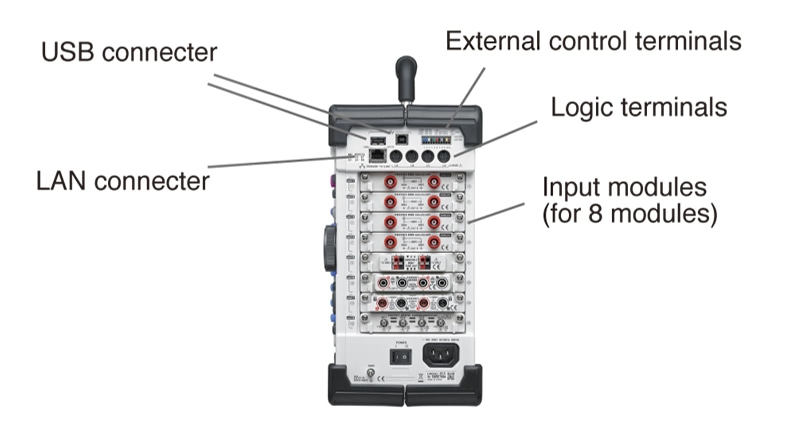What is a Memory HiCorder?
Basic principle of Memory HiCorders
Typical waveform recording instruments have included the oscilloscope, electromagnetic oscillograph, and pen oscillograph (a category that includes pen recorders). With progress in digital technology, analog oscilloscopes gave way to digital oscilloscopes, while electromagnetic oscillographs and pen oscillographs gave way to memory-based recorders (transient recorders).
The Memory HiCorder is such a memory-based recorder. The A/D converters function to convert input analog signals into digital signals, which are then stored in the instrument’s memory and displayed or printed as waveforms.
Comparison with analog recorders
This section explains why analog pen oscillographs (pen recorders) and electromagnetic oscillographs were replaced by Memory HiCorders.
Pen oscillographs are self-balancing recorders with servomotors that operate in proportion to the amplitude of input signals to move pens and thereby record signal data. They have a response speed on the order of dozens of hertz, but their use of mechanical means to represent amplitude imposes limits on that speed, and ink-type variants require regular maintenance.
Electromagnetic oscillographs use high-sensitivity reflecting elements that are deflected according to the amplitude of the input signals in order to reflect light from a light source onto photosensitive recording paper. This method of measurement is capable of attaining high-speed recording with paper feed speeds of up to 200 centimeters per second (5 ms/cm) and response speeds on the order of several kilohertz, but it suffers from difficulties in the form of the high running costs associated with the photosensitive paper (resulting from the instrument’s high speed) and handling of the reflecting elements.
Memory HiCorders incorporate a thermal dot array printer (with a high resolution of 8 dots per millimeter) for printing recorded data, and this design offers high reliability due to the absence of moving parts such as pens. The instruments generally offer high response speeds, with sampling speeds of up to 20 MS/s (50 ns). They also combine extensive trigger functionality with low running costs, since users can retrieve only that waveform data which is necessary. Despite enhanced functionality and performance, the instruments have fallen in price, and for these reasons they have displaced electromagnetic oscillographs and pen recorders.
Memory HiCorder part names and functions
Memory HiCorders provide a color LCD for displaying waveforms and a printer for printing them. Both the display and printer can generate output in real time for certain signal loads. (Data acquired at a sampling speed of at least 10 kS/s is displayed on the screen in real time.)
With a maximum sampling speed of 20 MS/s, Memory HiCorders are slower than digital oscilloscopes, but they are characterized by the ability to accept input of numerous signals without use of isolation amplifiers or concern for potential differences between signals.
Recorded data can be stored on the instrument’s built-in SSD, a CF card, or a USB flash drive.
Each input unit generally provides two channels of input, and the instrument can accommodate input of up to 1000 V DC (700 V AC) as well as dynamic strain, thermocouple, logic, and other input simply by switching input units.
By connecting the instrument to a computer via its USB or LAN interface, users can transfer data and control the instrument remotely.

 Memory Hicorder part names and functions
Memory Hicorder part names and functions
Memory HiCorder applications (Difference from digital oscilloscopes and data loggers)
Currently available recording and waveform observation instruments can be broadly divided into three categories: oscilloscopes in the high-speed segment of the market, Memory HiCorders in the medium- and low-speed segment of the market, and data loggers in the low-speed segment of the market. Customers choose instruments based on the frequency of the signal waveform being measured and recording interval, or based on characteristics such as input signal voltages, if the circuit being measured has a different ground potential.
While digital oscilloscopes excel in their ability to observe high-speed phenomena, their use of a common ground for all channels introduces the risk of shorts between circuits and ground faults when measuring circuits that are at different potentials relative to ground or when measuring targets such as mechatronic control circuits that mix strong and weak currents.
Since Memory HiCorders use isolated channels, they are able to perform tasks such as measuring DC control signals while observing a commercial power supply’s AC waveform or recording waveforms between inverter or converter inputs and outputs. As a result, they shine in applications involving measurement of circuits mixing strong and weak currents, as mentioned above.
Thanks to improvements in sampling speeds, Memory HiCorders have frequency characteristics that exceed the audible frequency range, and as discussed above, an extensive range of input units gives them capabilities ranging from electrical measurement to measurement of mechanical and vibration physical properties. Figure 1-6 illustrates the frequency bands for signal waveforms and compatible waveform measuring instruments in a variety of fields.




